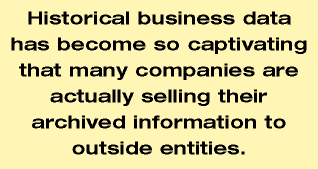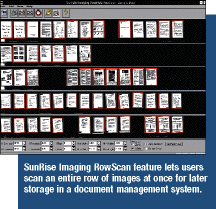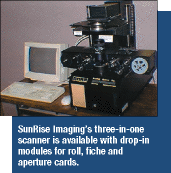|
Enterprise Storage Solutions For Data & Document Management
Archived microfilm represents a treasure trove of enterprise storage
By James Lucas, VP of Sales and Marketing
SunRise Imaging
The paperless office is, for the most part, an unfulfilled promise from the past. Despite the hype from system providers and the desire of the end user to go digital, intranet technology and the cost of hardware required to fulfill the dream were either not yet available or far too costly.
Microfilm, on the other hand, became a practical and popular method of replacing paper as an information storage medium. The space required to store microfilm is dwarfed by paper file cabinet space needs. In addition, microfilm systems offered users fast and reliable access to the information captured on the celluloid. Savings in space and easy access made microfilm systems popular with cost conscious corporate managers.
Nevertheless, the dream of a digital world continued to haunt us--it is/ was a notion that began to look out of reach. Fortunately, things are changing rapidly. Today, technology is racing forward at a blinding pace while the cost of computers, RAM, disk memory and other technologies is plummeting on a daily basis. With improved technology and lower costs, the ability of most organizations wanting to surf their own intranet or the Internet is easily achievable. Consequently, the digital dream is finally a reality.

The increasing popularity of the Internet and corporate intranets is the source of a renewed appreciation by many forward-thinking companies regarding the intrinsic value of historical data. Not only is this data useful in the strategic planning process, it also can help identify new customers and fine-tune targeted marketing and positioning goals.
Historical business data has become so captivating that many companies are actually selling their archived information to outside entities. Consequently, "data mining" (searching through the mass of old databases and extracting usable data) has become an emerging industry. A major deterrent to this burgeoning new phenomenon has been a somewhat common but provincial attitude concerning the number one storage medium of archived files--microfilm.
Conventional wisdom dictates that once a document is captured on film, the information is only available at a considerable cost. After all, traditional techniques for liberating microfilmed information are slow and laborious when compared to digital methods. First, the records manager must sift through and find the relevant record. Once the record is located, it must be printed, copied and distributed. Yes, it's tedious and time-consuming, but some progress has been made in retrieving microfilm data and speeding up the earlier methods.
Computer-aided retrieval (CAR) systems, for example, were designed to overcome many challenges faced by researchers when seeking specific information. However, manipulating and disseminating the data after it has been located has not been possible in the past without re-keying it from a copy or from the microfilm viewing screen.
A massive amount of useful information is simply waiting to be released from microfilm. It has been the storage medium of choice for many years because it offers a low-cost, permanent option for storing data. Furthermore, it was and is the only medium, besides paper, that can be accepted as a legal document in many states across our country. As a result, more than 1 trillion pages of archived data are estimated to be stored on microfilm, according to Mitch Badler, editor of Micrographics Newsletter.
New methods unlock
microfilmed information
Downloading microfilm is a dream that has become a reality. Today, solutions actually allow you to unlock the mass of data kept on microfilm and send it electronically from one point to another. Microfilm archives are converted to electronic images by simply scanning the microfilm with a special digitizing camera to create a digital file of each image on the film. From there, each image can be indexed to allow simplified and speedy access and substantially improved data-mining capabilities. This solution is simple and cost-effective; equally important, the technology exists to make it feasible.
The process required to scan film and digitize those images is quick, easy and highly productive. Rolls of 16mm and 35mm microfilm can be loaded onto a high-speed digitizing scanner such as the SunRise P150 and quickly converted to digital images. Images can be converted at a rate exceeding 120 pages per minute. Also, 105mm fiche and even jacketed fiche can be converted at similar speeds using SunRise's RowScan product. Technology is available that scans aperture cards or complete fiche, then locates and segments the fiche into individual frames electronically. These products allow one operator to handle as many as four scanners, or conversely perform other functions at the same time as scanning.
Digital images add value to microfilm data
Converting microfilm to digital images is not an expensive proposition. In fact, it is almost always less expensive than converting paper, because it requires less labor. More importantly, an added benefit is that images scanned from film are often of substantially higher quality, contributing to readability and usefulness, when compared to digital images converted from paper. What's more, scanners like the SunRise P150 that incorporate image enhancement technologies can take "bad" film and drastically improve the image in several ways:
* Microfilm can vary in contrast and brightness. It can also be faded or out-of-focus. Scanners such as SunRise's P150 that incorporate image enhancement can improve the image threefold.
* Microfilm often varies slightly in resolution. Consequently, an adequate scanner must allow for variable focus, rather than a fixed focus. With the SunRise P150, the operator can specifically focus the scanner to match film resolution.
* Microfilm can be in comic or cine modes--meaning that it can be straight to the film direction or at a 90-degree angle. Duplex microfilm can consist of frames, one the right way up and the other 180 degrees opposed. Technology like SunRise's real-time rotation will adjust the scanned digital images so that all of the images are right side up.

* Jacketed fiche can contain separate images that are individually skewed. Each frame can be located in a different relationship to its neighboring frame. And individual frames can vary in size and orientation. SunRise's RowScan allows you to locate those images without rescanning.
After the microfilm images are scanned, they can be placed in a digital document management system, copied, transmitted or published internally over an intranet or externally over the Internet. The results are improved customer service and immediate access to archives.
Digital images
facilitate life insurance company's move
Columbus Life Insurance was a highly respected name in Columbus, OH, and its system for managing policy records was long established and reliable. Unfortunately, that system, which was based on jacketed microfiche, was also unwieldy, causing slow response times to policy holder inquiries.
When the decision was made to relocate Columbus Life from its hometown to Cincinnati, OH (to the headquarters of its parent company, Western Southern Life), the need for change became clear. As Patrick Walsh, manager of Western Southern Life's Advanced Technology Group explained, "Moving huge quantities of jacketed fiche from Columbus to Cincinnati was impractical." What was needed was a conversion of the microfiche to electronic images to expedite the move and facilitate smooth operation of the company's future policy holder services.
Studies quickly showed that the task of moving paper files was enormous. Life insurance is a paper-intensive business with numerous old, yet active, policy records that require periodic updating. In the case of Columbus Life, these records included some
4 million jacketed microfiche, each jacket with up to 50 images--meaning there were 20 million potential images to convert. But Columbus Life and Western Southern demonstrated their commitment to the future by choosing to move ahead technologically as well as physically. This meant advancing from desktop terminals, microfiche readers and typewriters to PCs, imaging and workflow. One hundred and sixty workstations were equipped with the latest hardware and software for high-speed document image processing and retrieval to accommodate the new system.

To date, Columbus Life and Western Southern have converted about 3.5 million images. By keeping its plan flexible and working with situations as they evolve, Columbus Life has been able to make the best use of its resources during this time of transition. Mr. Walsh enthusiastically said, "This has been one of the best projects I have ever worked on. It was a unique period of time; it has been fun and a great learning experience."
It's up to you. Continue using microfilm with traditional methods thereby limiting access to the information--or take advantage of proven conversion techniques and put your valuable microfilm information to better and more profitable use. *
James Lucas heads up the sales and marketing groups for SunRise Imaging (Fremont, CA). Previously, he held management positions in the prepress and CAD/CAM industries. For more information, please call 510-657-6250 or fax to 510-770-9209.
|

![]()
![]()
